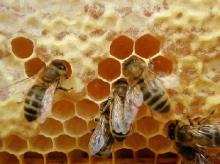Beehives are composed from many tubes that are clustered and closely stuck together in what is called a honeycomb structure. Looking closely at each tube, you can see that the cross-section is in the shape of a hexagon. Why a hexagon? Equilateral triangles, equilateral tetragons, and equilateral hexagons can line up against each other without any gaps, while equilateral pentagons produce gaps. If you try lining up any equilateral polygon with seven or more sides, there will definitely be gaps. Circles will create gaps as well. Equilateral hexagons are the most efficient shape for creating a broad surface with little material and therefore less weight. Furthermore, it is known that this shape is extremely sturdy. For example, the walls of a Japanese honeybee’s beehive are 0.1mm thick, but the approximately 4,000 cells in the walls can store up to 2kg of honey. Since the walls of the beehive are made of wax and saliva secreted by the honeybee itself, it is extremely important for the honeybee to use as little material as possible to form the walls. Also, bees care for their larvae inside the beehive, so it has the function of a “cradle” as well. In order to protect the precious babies of the bees, the beehive is made to be very sturdy.
- Efficiency(Energy Saving, Resource Saving, Light):
- Weight-saving、High intensity
The honeycomb structure is used everywhere around us, with applications including soccer nets, boards for desks, and the seats of chairs. The honeycomb structure also has many industrial applications. When it comes to the wings and wall parts of airplanes, the honeycomb structure is utilized in order to keep the body of the aircraft very strong yet light at the same time. The honeycomb structure is used for the framework, adopted as part of a “sandwich” structure and held between the front and back walls. This structure is exactly the same as a cross-section of cardboard. With a honeycomb structure, the walls are incredibly strong compared with what they would have been with the strength of just a single board. In addition, the honeycomb structure supports our daily lifestyle in unseen places, such as with the floors of high-speed bullet trains or the walls of artificial satellites. How amazing that the knowledge of tiny bees has even reached into outer space.
- Soccer nets, boards for desks, seats of chairs, floors of high-speed bullet trains, walls of artificial satellites.
A honeycomb structure consists of not one hexagon-shaped tube, but many of them lining up together to cover a level surface. Honeycombs make up the internal structure of a beehive. Beehives, which incorporate this honeycomb structure composed of hexagonal cells, are remarkably light and sturdy. The same honeycomb structure can also be seen elsewhere in nature, such as with the compound eyes of dragonflies and flies, as well as turtle shells. By researching honeycomb structures, we may be able to develop sturdier, lighter materials.


















